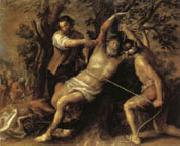 |
Francisco Camilo -- Click Here
|
|
Spanish painter (b. 1615, Madrid, d. 1673, Madrid)
was an Italian painter of the Renaissance period. He was born at Bassano del Grappa near Venice, the eldest son of Jacopo Bassano and grandson of Francesco da Ponte the Elder. He studied with his father and worked in the Bassano family workshop along with his three brothers, including Giambattista and Girolamo. He moved to Venice where he ran the branch of the family business, and where he was employed to paint a series of historical pictures in the Doge's Palace, but prone to hypochondria and other ailments, committed suicide by throwing self-defenestration soon after his father's death in 1592. |
|
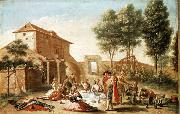 |
Francisco Bayeu y Subias -- Click Here
|
|
Spanish Painter, 1734-1795,was a Spanish painter, active in a Neoclassic style, whose main subjects were religious and historical themes. Born in Zaragoza, he received a broad childhood education. His initial art studies were with a local master, Jose Luzan[1] and Antonio Gonzalez Velazquez. He then moved to Madrid, winning a scholarship with the painting of the ????Tyranny of Gerion???? to study in the Academia Real de Bellas Artes de San Fernando. The death of his parents and the care of his brothers forced him to return to Zaragoza, until he was recalled by Anton Raphael Mengs to help decorate the Royal Palace of Madrid. In later years, one of his colleagues was Francisco Goya, who married his sister, Josefa Bayeu. He served as court painter to King Charles III of Spain. He was named a professor of the Royal Academy of Fine Arts of San Fernando in 1765 and director in 1788. He painted in the Charterhouse of Aula Dei in Zaragoza. In 1767 he was named court painter for Charles III, king of Spain. He was involved in the decoration of various Royal palaces near Madrid. |
|
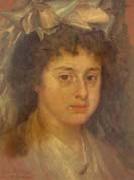 |
Francisco Bayeu -- Click Here
|
|
Spanish painter ,
1734, Zaragoza, Spain - 1795, Madrid
was a Spanish painter, active in a Neoclassic style, whose main subjects were religious and historical themes. Born in Zaragoza, he received a broad childhood education. His initial art studies were with a local master, Jos?? Luz??n[1] and Antonio Gonz??lez Vel??zquez. He then moved to Madrid, winning a scholarship with the painting of the ????Tyranny of Gerion???? to study in the Academia Real de Bellas Artes de San Fernando. The death of his parents and the care of his brothers forced him to return to Zaragoza, until he was recalled by Anton Raphael Mengs to help decorate the Royal Palace of Madrid. In later years, one of his colleagues was Francisco Goya, who married his sister, Josefa Bayeu. He served as court painter to King Charles III of Spain. He was named a professor of the Royal Academy of Fine Arts of San Fernando in 1765 and director in 1788. He painted in the Charterhouse of Aula Dei in Zaragoza. In 1767 he was named court painter for Charles III, king of Spain. He was involved in the decoration of various Royal palaces near Madrid. |
|
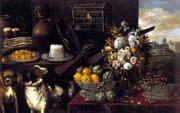 |
Francisco Barrera -- Click Here
|
|
Spanish, 1595-1657,Spanish painter. Although he is sometimes thought to have been a Sevillian painter, his career is documented in Madrid. Barrera enjoyed considerable prestige and authority within the artistic community of the Spanish capital and in 1634 and 1639 represented his profession in significant legal battles concerning the status and rights of painters. However, Barrera's known paintings, all of which are still-lifes, are those of a derivative artist of modest abilities. In Still-life with Basket of Grapes, signed and dated 1642 (Florence, Uffizi), his arrangement of objects in a window-frame and on a stone ledge derives from works by Juan van der Hamen y Le?n but without that artist's refined compositional sense or mastery of pictorial space. The rather weak modelling of objects in this painting is consistent with Barrera's other still-lifes, which are further characterized by their light tonality, bland colouring and monotonous brushwork. Comparable stylistic features are found in the more accomplished still-lifes of Antonio Ponce, with whom Barrera is documented in the 1630s. Barrera's best works are those depicting the Four Seasons, signed and dated 1638 (Seville, priv. col., see 1982 exh. cat., pp. 78-85). These are still-lifes of abundant seasonal foodstuffs and, in landscape settings, large symbolic and genre figures drawn from traditional iconography. |
|
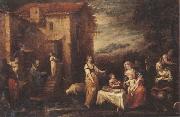 |
Francisco Antolinez y Sarabia -- Click Here
|
|
Spanish Painter , Seville circa 1644-circa1700
|
|
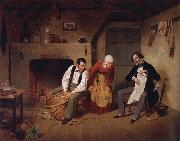 |
Francis William Edmonds -- Click Here
|
|
American, 1806-1863,American painter and banker. He achieved recognition both as a painter and as a banker, juggling careers with consummate skill. In 1826 he enrolled at the National Academy of Design while working in a New York bank. Somewhat insecure, he initially exhibited between 1836 and 1838 under the pseudonym E. F. Williams, but favourable reviews subsequently prompted him to use his own name. In 1840-41 Edmonds spent eight months in Europe, where he studied the Old Masters; he particularly admired the 17th-century Dutch painters Pieter de Hooch and Gabriel Metsu. |
|
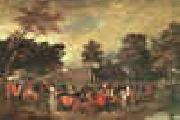 |
Francis Wheatley -- Click Here
|
|
1747-1801
British Francis Wheatley Location
Francis Wheatley (1747 - June 28, 1801), was an English portrait and landscape painter, was born at Wild Court, Covent Garden, London. He studied at Shipleys drawing-school and the Royal Academy, and won several prizes from the Society of Arts. He assisted in the decoration of Vauxhall, and aided Mortimer in painting a ceiling for Lord Melbourne at Brocket Hall (Hertfordshire). In youth his life was irregular and dissipated. He eloped to Ireland with the wife of Gresse, a brother artist, and established himself in Dublin as a portrait-painter, executing, among other works, an interior of the Irish House of Commons. His scene from the Gordon Riots of 1780 was engraved by Heath. He painted several subjects for Boydells Shakespeare Gallery, designed illustrations to Bells edition of the poets, and practised to some small extent as an etcher and mezzotint-engraver. It is, however, as a painter, in both oil and water-color, of landscapes and rustic subjects that Wheatley is best remembered. He was elected an associate of the Royal Academy in 1790, and an academician in the following year. His wife, as Mrs Pope after his death, was known as a painter of flowers and portraits. |
|
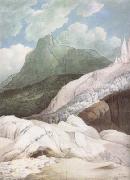 |
Francis Towne -- Click Here
|
|
English Painter, 1739-1816
was an English water-colour painter. He was born in Isleworth, Middlesex, the son of a corn chandler. Apprenticed to a coach painter in London, he won a design prize from the Society of Arts, and studied for a while at St Martin??s Lane Academy. In 1763 he was employed by a coach painter called Thomas Watson, and went to Exeter on business. He had already begun painting in oils and also taught drawing, and now he began to accept commissions from wealthy families in Devon. After a tour of north Wales in 1777, undertaken with his friend, the lawyer John White, he began to specialize in water-colours. In 1780 he travelled to Rome and from there to Naples. On his return to Devon, he was asked by Sir Thomas and Lady Acland of Killerton to paint some views in Devon and North Wales, and in 1786 he went on a painting tour of the Lake District |
|
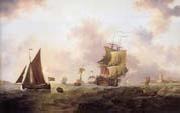 |
Francis Swaine -- Click Here
|
|
1720-1783,English painter and draughtsman. He worked as a messenger for a department of His Majesty's Navy in 1735 and seems to have been practising as a marine painter by the late 1740s, but there is little trace of his place in London's art world until his regular contributions from 1761 to the exhibitions of both the Free and Incorporated Societies of Artists. He was awarded the Society for the Encouragement of Arts' second prize for sea-pieces in 1764 and again in 1765. 'About the year 1770', reported Edwards, 'he painted the face of a wind-dial, with sea and ships, which he executed with a great neatness' |
|
|
|
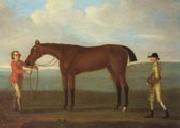 |
Francis Sartorius -- Click Here
|
|
Scottish , 1734-1804 |
|
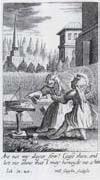 |
Francis Quarles -- Click Here
|
|
1592-1644,was born at Romford, London Borough of Havering, and baptized there on May 8 1592. Francis traced his ancestry to a family settled in England before the Norman Conquest with a long history in royal service. His great-grandfather, George Quarles, was Auditor to Henry VIII, and his father, James Quarles, held several places under Elizabeth I and James I, for which he was rewarded with an estate called Stewards in Romford. His mother, Joan Dalton, was the daughter and heiress of Eldred Dalton of Mores Place, Hadham. There were eight children in the family; the eldest, Sir Robert Quarles, was knighted by James I in 1608. Francis was entered at Christ's College, Cambridge, in 1608, and subsequently at Lincoln's Inn. He was made cupbearer to the Princess Elizabeth, in 1613, remaining abroad for some years; and before 1629 he was appointed secretary to Ussher, the primate of Ireland. About 1633 he returned to England, and spent the next two years in the preparation of his Emblems. In 1639 he was made city chronologer, a post in which Ben Jonson and Thomas Middleton had preceded him. At the outbreak of the Civil War he took the Royalist side, drawing up three pamphlets in 1644 in support of the king's cause. It is said that his house was searched and his papers destroyed by the Parliamentarians in consequence of these publications. Quarles married in 1618 Ursula Woodgate, by whom he had eighteen children. His son, John Quarles (1624-1665), was exiled to Flanders for his Royalist sympathies and was the author of Fons Lachrymarum (1648) and other poems. The work by which Quarles is best known, the Emblems, was originally published in 1635, with grotesque illustrations engraved by William Marshall and others. The forty-five prints in the last three books are borrowed from the Pia Desideria (Antwerp, 1624) of Herman Hugo. Each "emblem" consists of a paraphrase from a passage of Scripture, expressed in ornate and metaphorical language, followed by passages from the Christian Fathers, and concluding with an epigram of four lines. The Emblems was immensely popular with the common people, but the critics of the 17th and 18th centuries had no mercy on Quarles. Sir John Suckling in his Sessions of the Poets disrespectfully alluded to him as he "that makes God speak so big in's poetry." Pope in the Dunciad spoke of the Emblems, "Where the pictures for the page atone And Quarles is saved by beauties not his own." |
|
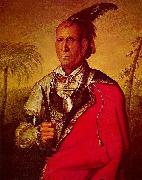 |
Francis Parsons -- Click Here
|
|
painted Cunne Shote in 1762 |
|
 |
Francis Oliver Finch -- Click Here
|
|
British watercolour painter, 1802-1862 |
|
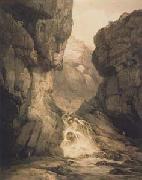 |
Francis Nicholson -- Click Here
|
|
English Painter, 1753-1844
English painter. After studying with a local artist in Scarborough, Nicholson began his career in his native Pickering, producing sporting pictures and portraits for Yorkshire patrons. In the mid-1780s a sideline in portraits of country houses led him to concentrate on landscapes in watercolour. From 1789 he contributed views of Yorkshire and Scotland to exhibitions at the Royal Academy. He also supplied topographical views for the Copper Plate Magazine. Although his market increasingly became London-based, Nicholson continued to live in Yorkshire (at Whitby, Knaresborough and Ripon), only moving to London c. 1803. |
|
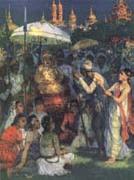 |
Francis Luis Mora -- Click Here
|
|
Uruguayan-born American Painter, 1874-1940 |
|
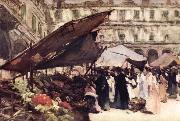 |
Francis Hopkinson Smith -- Click Here
|
|
Engineer, artist, illustrator, and short story writer
American , 1838-1915
United States author, artist and engineer, was born in Baltimore, Maryland, a descendant of Francis Hopkinson, one of the signers of the Declaration of Independence. Smith became a contractor in New York City and did much work for the federal government, including the stone ice-breaker at Bridgeport, Connecticut, the jetties at the mouth of the Connecticut River, the foundation for the Bartholdi Statue of Liberty in New York Harbor, the Race Rock Lighthouse (southwest of Fishers Island, New York) and many life-saving stations. His vacations were spent sketching in the White Mountains, in Cuba and in Mexico. |
|
 |
Francis Holman -- Click Here
|
|
(1729-1784) was a British maritime painter, little recognised during his own lifetime, but whose paintings are now sought aftereHe is also notable as the teacher of Thomas Luny.
He was born in Ramsgate and baptized on 14 November 1729 at St Laurence-in-Thanet, Ramsgate.[1] He was the eldest son and second of six children of Francis Holman (1696-1739), and his wife, Anne Long (1707-1757). His father was a master mariner, and his grandfather a Ramsgate cooper. His younger brother, Captain John Holman (1733-1816), maintained the family shipping business and remained close to Francis throughout his life. Young Francis would certainly have been immersed in the maritime world during his up-bringing; the legacy of this early knowledge is a wealth of detail and accuracy in his later work.
The moonlight Battle of Cape St Vincent, 16 January 1780 by Francis Holman, painted 1780
A sixth-rate British man of war off Dover, by Francis Holman, 1777
A small shipyard on the Thames, by Francis Holman, between 1760 and 1784Francis Holman lived in at least five addresses in Wapping on the Thames in London. He married, firstly, Elizabeth, and they produced 3 sons; John (b. 1757), and two more sons, both named Francis, who died in infancy. Elizabeth's death is unrecorded, but on 7 May 1781 he married, secondly, Jane Maxted (c.1736-1790). He was apparently childless when he wrote his will in 1783.
|
|
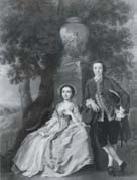 |
Francis Hayman -- Click Here
|
|
English Painter, 1708-1776,English painter and illustrator. He was in London at the age of 10, and from 1718 until c. 1725 he was apprenticed to Robert Brown (d 1753), a decorative painter. From 1732 Hayman was employed as a scene painter at Goodman's Fields Theatre, where he painted allegorical works such as The King Attended by Peace, with Liberty and Justice Trampling on Tyranny and Oppression on the pit ceiling (destr.). He moved to Drury Lane Theatre in 1736, shortly before the Licensing Act closed Goodman's Fields. At Drury Lane he painted scenery for Thomas Arne's masque The Fall of Phaeton (1736) and was praised for his naturalistic landscapes. From the late 1730s he began accepting commissions for portraits and conversation pieces. His success in the field of portraiture rested on the dearth of good portrait painters in England at the time and his exploitation of a growing middle-class clientele. Hayman painted portraits of doctors, literary men and actors. |
|
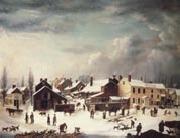 |
Francis Guy -- Click Here
|
|
American Colonial Era Painter, 1753-1820 |
|
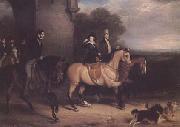 |
Francis Grant -- Click Here
|
|
Scottish Painter, 1803-1878
Scottish portrait painter. He was self-taught in painting, for which he abandoned a career in law. He began as a painter of hunting scenes (The Melton Hunt and The Cottesmore Hunt) but gained success as a fashionable portrait painter. Among his sitters were Scott, Macaulay, Disraeli, Palmerston, and Landseer. Sir Francis was president (1866 C 78) of the Royal Academy. |
|
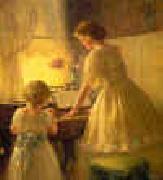 |
Francis Day -- Click Here
|
|
Francis Day CIE (1829-1889) was Inspector-General of Fisheries in India(from circa 1871) and Burma and an ichthyologist.
He was born on the 2nd of March 1829 Maresfield, Sussex, UK third son of William and Ann Day. He became the medical officer in the Madras Presidency, East India Company services in 1852.
Francis Day was created a Companion of the Order of the Indian Empire in 1885. He was decorated with the 0rder of the crown of Italy. He retired in 1877.
He wrote a monograph on fishes between 1875-1878 "The Fishes of India" with a supplement in 1888 and two volumes on "Fishes" in the Fauna of British India series in which he described over 1400 species. Also wrote British and Irish Salmonadae, which he illustrated with 9 plates, the colouring of which was done by Miss Florence Woolward. Francis Day was granted an honary LLD by the University of Edinburgh.
Also Published Fishes of Malabar in 1865
Franics Day was an active member, and president of the Cheltenham Natural Sciences Society and presented papers to them. Also was an active member of the Cotswold Field Club, where he was vice president. He died at his residence, Kenilworth House, Cheltenham on the 10th of July 1889 of cancer of the stomach. Buried in Cheltenham cemetery. |
|
 |
Francis Davis Millet -- Click Here
|
|
(November 3, 1846 - April 15, 1912) was an American painter, sculptor, and writer who died in the sinking of the RMS Titanic on April 15, 1912.
Francis Davis Millet was born in Mattapoisett, Massachusetts. At age sixteen, Millet entered the Massachusetts regiment, first as a drummer boy and then a surgical assistant in the American Civil War. He repeatedly pointed to his experience working for his father as giving him an appreciation for the vivid blood red that he repeatedly used in his early paintings. |
|
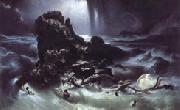 |
Francis Danby -- Click Here
|
|
Irish Painter, 1793-1861
was a British painter of the Romantic eraBorn in the south of Ireland, he was one of a set of twins; his father, James Danby, farmed a small property he owned near Wexford, but his death, in 1807, caused the family to move to Dublin, while Francis was still a schoolboy. He began to practice drawing at the Royal Dublin Society's schools; and under an erratic young artist named James Arthur O'Connor he began painting landscapes. Danby also made acquaintance with George Petrie, and all three left for London together in 1824. This expedition, undertaken with very inadequate funds, quickly came to an end, and they had to get home again by walking. At Bristol they made a pause, and Danby, finding he could get trifling sums for water-color drawings, remained there working diligently and sending to the London exhibitions pictures of importance. There his large oil paintings quickly attracted attention. Danby painted "vast illusionist canvases" comparable to those of John Martin of "grand, gloomy and fantastic subjects which chimed exactly with the Byronic taste of the 1820s."The Upas Tree (1820) and The Delivery of the Israelites (1825) brought him his election as an Associate Member of the Royal Academy. He left Bristol for London, and in 1828 exhibited his Opening of the Sixth Seal at the British Institution, receiving from that body a prize of 200 guineas; and this picture was followed by two others on the theme of the Apocalypse. In 1829 Danby's wife deserted him, running off with the painter Paul Falconer Poole Danby left London, declaring that he would never live there again, and that the Academy, instead of aiding him, had, somehow or other, used him badly. For a decade he lived on the Lake of Geneva in Switzerland, becoming a Bohemian with boat-building fancies, painting only now and then. He later moved to Paris for a short period of time. He returned to England in 1840, when his sons, James and Thomas, both artists, were growing up. Danby exhibited his large (15 feet wide) and powerful The Deluge that year; the success of that painting, "the largest and most dramatic of all his Martinesque visions, revitalized his reputation and career. Other pictures by him were The Golden Age (c. 1827, exhibited 1831), Rich and Rare Were the Gems She Wore (1837), and The Evening Gun (1848). Some of Danby's later paintings, like The Woodnymph's Hymn to the Rising Sun (1845), tended toward a calmer, more restrained, more cheerful manner than those in his earlier style; but he returned to his early mode for The Shipwreck (1859). |
|
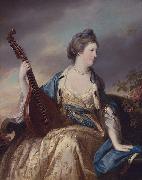 |
Francis Cotes -- Click Here
|
|
(20 May 1726 - 16 July 1770) was an English painter, one of the pioneers of English pastel painting, and a founder member of the Royal Academy in 1768.
He was born in London, the eldest son of Robert Cotes, an apothecary (Francis's younger brother Samuel Cotes (1734 - 1818) also became an artist, specialising in miniatures). Cotes trained with portrait painter George Knapton (1698 - 1778) before setting up his own business in his father's business premises in London's Cork Streetelearning, incidentally, much about chemistry to inform his making of pastels.
An admirer of the pastel drawings of Rosalba Carriera, Cotes concentrated on works in pastel and crayon (some of which became well-known as engravings). After pushing crayon to its limit as a mediumealthough he was never to abandon it entirelye - otes turned to oil painting as a means of developing his style in larger-scale works. In his most successful paintings, particularly those of the early 1760s, the oil paint is thinly applied, in imitation of his pastel technique, and imbued with charm, inviting comparisons with Allan Ramsay (1713 - 1784) and Sir Joshua Reynolds. They have clarity and warmth and possess a remarkable attention to costume. In 1763, he bought a large house (later occupied by George Romney) in Cavendish Square.
One of the most fashionable portrait painters of his day, Cotes helped found the Society of Artists and became its director in 1765. At the peak of his powers, Cotes was invited to become one of the first members of the Royal Academy, but died just two years later, aged 44, in Richmond.
He also taught pastel skills to John Russell, and his skills were described in book The Elements of Painting with Crayon.
|
|
|
|
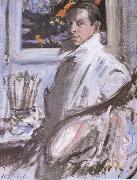 |
Francis Campbell Boileau Cadell -- Click Here
|
|
Scottish, 1883-1937, was a Scottish painter associated with the Scottish Colourists. Francis Cadell was born in Edinburgh and, from the age of 16, studied in Paris at the Academie Julian, where he was in contact with the French avant-garde of the day. While in France, his exposure to work by the early Fauvists, and in particular Matisse, proved to be his most lasting influence. After his return to Scotland, he was a regular exhibitor in Edinburgh and Glasgow, as well as in London. He painted landscapes, interiors, still life and figures in both oil and watercolour, but he is particularly noted for his portraits, depicting his subject with vibrant waves of colour. He enjoyed the landscape of Iona enormously, which he first visited in 1912 and features prominently in his work. |
|
 |
Francis Barraud -- Click Here
|
|
(14 November 1899 - 11 September 1934) was a Swiss painter.
Barraud was the eldest of four brothers who all painted or sculpted at various points in their lives.The brothers, François, Aim, Aurle and Charles, were largely self-taught artists having been raised as professional plasterers and house painters. Barraud attended evening classes at the local art school in 1911 together with his brothers. In 1919, he exhibited his paintings in La Chaux-de-Fonds and participated in the National Exhibition of Fine Arts in Basel.Encouraged by the success of the exhibitions he left Switzerland in 1922, and moved to Reims in France where he worked as a house painter for two years. He married Marie, a French woman, in 1924. Marie subsequently featured as a model in several of his paintings.Around 1924 or 1925, Barraud found work in Paris as an artist and craftsman. While living in Paris he studied painting at the Louvre.
François Barraud painted mainly still lifes, female nudes and portraits, including several double portraits of himself and his wife, Marie His precise, realist style of painting developed under the influence of the old Flemish and French masters he had studied at the Louvre.
Barraud suffered periods of illness throughout his life and died of tuberculosis in Geneva, in 1934, at the age of 34. |
|
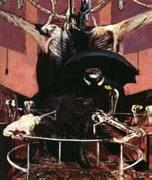 |
Francis Bacon -- Click Here
|
|
English , 1561-1626
British statesman and philosopher, father of modern scientific method. He studied at Cambridge and at Gray's Inn. A supporter of the Earl of Essex, Bacon turned against him when Essex was tried for treason. Under James I he rose steadily, becoming successively solicitor general (1607), attorney general (1613), and lord chancellor (1618). Convicted of accepting bribes from those being tried in his court, he was briefly imprisoned and permanently lost his public offices; he died deeply in debt. He attempted to put natural science on a firm empirical foundation in the Novum Organum (1620), which sets forth his scientific method. His elaborate classification of the sciences inspired the 18th-century French Encyclopedists, and his empiricism inspired 19th-century British philosophers of science. His other works include The Advancement of Learning (1605), |
|
|
|
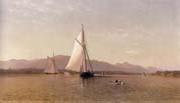 |
Francis A.Silva -- Click Here
|
|
American Hudson River School Painter, 1835-1886 |
|
 |
FRANCIABIGIO -- Click Here
|
|
Italian High Renaissance Painter, 1484-1525
Italian painter. The son of a Milanese linen-weaver, he had completed his apprenticeship, in Florence, by 18 October 1504. His earliest documented works, for example a Piete (1506) for S Pancrazio, Florence, have not survived. According to Vasari, Franciabigio trained with Mariotto Albertinelli, in whose last work, the signed and dated Crucifixion (1506; Florence, Certosa del Galluzzo, Pin.), he painted the angels (Shearman). In December 1508 the names of Franciabigio and Andrea del Sarto, who sometime between autumn 1506 and 1509 set up a joint workshop, were entered in the registration book of the Arte de' Medici e Speziali, to which painters were required to belong. The Portrait of a Young Man (Paris, Louvre) dates from this period. The work, which was later enlarged, shows the subject half-length, leaning pensively against a balustrade, with strong areas of shadow around the eyes. This is the first in a series of male portraits typical of Franciabigio: the subjects, each of whom wears a hat, are mostly placed in front of a landscape, with their gaze fixed meditatively or piercingly on the onlooker. The religious works from this period, such as the Virgin and Child (1509; Rome, Pal. Barberini), also show a movement away from the style of Albertinelli and Raffaellino del Garbo and begin to reveal instead the influence of Leonardo, Michelangelo and, especially, Raphael. Yet Franciabigio's connection with Andrea del Sarto was the determining factor in his career. When in 1509 it was del Sarto who received the commission to complete the fresco cycle in the atrium of SS Annunziata, Florence, their relationship altered significantly. |
|
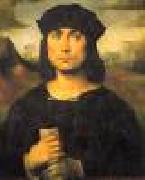 |
FRANCIA, Francesco -- Click Here
|
|
Italian High Renaissance Painter, 1450-1517
He turned to painting c. 1485, and his first works already testify to the considerable technical accomplishment and gentle religious sensibility that remained constants of his art. His major surviving paintings are altarpieces, mostly images of the Virgin and saints, initially done for Bologna and later for nearby centres, notably Parma, Modena, Ferrara and Lucca. He also painted many small-scale devotional works and a few portraits. The apochryphal anecdote reported by Vasari that Francia died on seeing Raphael's altarpiece of St Cecilia |
|
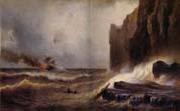 |
Francia Alexandre -- Click Here
|
|
French , 1815-Bruxelles 1884
|
|
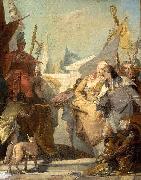 |
Francesco Zugno -- Click Here
|
|
Francesco Zugno (c. 1708-1787) was an Italian painter of the Rococo period. He was born in Brescia. Among his masterworks is a series of wall frescoes of figures in quadratura balconiesepart genre, part courtly conceit. He was strongly influenced by Giovanni Battista Tiepolo and his works. |
|
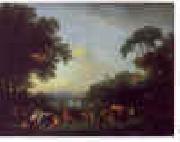 |
Francesco Zuccarelli -- Click Here
|
|
Italian 1702-1788
1788). Italian painter and draughtsman, active in England.
Zuccarelli training began in Florence, where he engraved the frescoes by Andrea del Sarto in SS Annunziata. He then studied in Rome under Paolo Anesi and learnt figure drawing from Giovanni Maria Morandi (1622-1717), although in this he never acquired any great skill. His earliest recorded paintings were Mary Magdalene and St Jerome (both untraced), which he contributed to the exhibition of the feast of St Luke in Florence in 1729. He also painted portraits. Around 1730 he moved to Venice and began painting landscapes exclusively. His interest in this field may have led to his becoming acquainted with the Welsh landscape painter Richard Wilson in 1750-51. Wilson painted a lively portrait of him (1751; London, Tate) in exchange for one of Zuccarellis landscapes. Zuccarelli avoided both the topographical type of Venetian view developed by Canaletto and the stormier landscapes of Marco Ricci, adopting instead a decorative landscape style of idealized Italian countryside. His subject-matter was usually unspecific rather than recognizably historical, biblical or mythological. For example, in the early 1740s he executed six paintings purporting to be scenes from the story of Jacob, but the paintings themselves bear few references to it (e.g. Landscape with Two Seated Women Embracing, 1743; Windsor Castle, Berks, Royal Col.). |
|
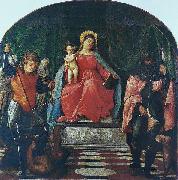 |
Francesco Vecellio -- Click Here
|
|
(c. 1475 - 1560) was an Italian painter of the early Renaissance, best known as the elder brother of the painter Titian. In his youth, he was a soldier. As a painter, he was mainly active in 1520-1530s in Cadore. In 1524, he signed an altarpiece for San Vito in Cadore. In 1540s, he painted a polyptych at Candide. In late 1540s he painted the organ shutters of San Salvatore in Venice. He painted an Annunciation for San Nicola di Bari, now in the Accademia.
|
|
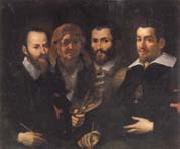 |
Francesco Vanni -- Click Here
|
|
Italian Baroque Era Painter, 1563-1610
was an Italian painter of the Mannerist style, active in Rome and his native city of Siena. He was half-brother of the painter Ventura Salimbeni, and the stepson of Arcangelo Salimbeni, another Sienese painter. His stepfather died when Francesco was young, and as a 16 year old went first to Bologna, then to Rome. There he apprenticed with Giovanni de' Vecchi during 1579-80, though like other Tuscan painters of his day, he was influenced in part by Federico Barocci from Urbino, and he was among the last painters who also reflected the influence of the Sienese School of painting. He was named a Cavalieri. In Rome, he worked later with Salimbeni, Bartolomeo Passerotti, and Andrea Lilio. He was commissioned by Pope Clement VIII to painted an altarpiece for the St. Peter's, later transferred to mosaic, Simon Magus rebuked by St. Peter. He painted several other pictures for Roman churches; including St. Michael defeats rebel angels for the sacristy of S. Gregorio; a Piet?? for Santa Maria in Vallicella; and the Assumption for S. Lorenzo in Miranda. Returning to Siena, where he ultimately died, he afterwards worked at Parma, Bologna, and again at Rome. At Siena, he painted a S. Raimondo walking on the Sea for the church of the Dominicans. Vanni painted a Baptism of Constantine (1586-7) for the church of San Agostino in Siena. He painted a Christ appearing to St. Catherine for the chapel of il Refugio at the Santuario Cateriniano of Siena, and a Baptism (1587) for the former church of San Giovannino e Gennaro. |
|
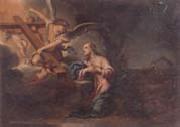 |
Francesco Trevisani -- Click Here
|
|
Italian Rococo Era Painter , Capodistria 1656-1746 Rome
was an Italian painter, active in the period called either early Rococo or late Baroque (barochetto) Born in Capodistria (modern Koper, then part of the Republic of Venice), he was the son of Antonio Trevisani, an architect, by whom he was instructed in the first rudiments of design. He then studied in Venice under Antonio Zanchi. He moved to Rome, where he remained until his death, in 1678. His brother, Angelo Trevisani remained a prominent painter in Venice. In Rome, he was supported by Cardinal Pietro Ottoboni. He was strongly influenced by Carlo Maratta, as it is manifest in his masterpiece, the frescoes in San Silvestro in Capite (1695-1696). In this commission, he worked alongside Giuseppe Chiari and Ludovico Gimignani. In Rome, he was favored with the patronage of Cardinal Chigi. Chigi employed him in several considerable works, and recommended him to the protection of Pope Clement XI, who not only commissioned him to paint one of the Prophets in San Giovanni Laterano, but engaged him to decorate the cupola of the cathedral in Urbino. There he represented, in fresco, allegories of the four Quarters of the World, in which he displayed much invention and ingenuity. He was employed by the Duke of Modena, in copying the works of Correggio, Parmigianino, and also painted in Brunswick, Madrid, Munich, Stockholm, and Vienna. He also shows Maratta's influence in the cartoons for baptismal chapel in St. Peter's Basilica, in the oval with Prophet Baruch in San Giovanni in Laterano, and in the Death of St. Joseph in Sant'Ignazio. Trevisani painted scenes from the Life of the Blessed Lucy of Narni in the church of Narni (1714-15). |
|
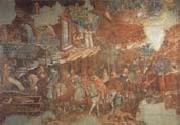 |
Francesco Traini -- Click Here
|
|
Italian Byzantine Style Painter, active 1321-1363 |
|
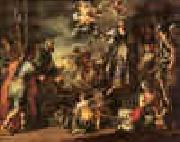 |
Francesco Solimena -- Click Here
|
|
1657-1747
Italian
Francesco Solimena Gallery
Francesco Solimena was born in Canale di Serino, near Avellino.
He received early training from his father, Angelo Solimena, with whom he executed a Paradise for the cathedral of Nocera (place where he spend a big part of his life) and a Vision of St. Cyril of Alexandria for the church of San Domenico at Solofra.
He settled in Naples in 1674, there he worked in the studio of Francesco di Maria and later Giacomo del Po[1]. He apparently had taken the clerical orders, but was patronized early on, and encouraged to become an artist by Cardinal Vincenzo Orsini (later Pope Benedict XIII)[2]. By the 1680s, he had independent fresco commissions, and his active studio came to dominate Neapolitan painting from the 1690s through the first four decades of the 18th century. He modeled his art??for he was a highly conventional painter??after the Roman Baroque masters, Luca Giordano and Giovanni Lanfranco, and Mattia Preti, whose technique of warm brownish shadowing Solimena emulated. Solimena painted many frescoes in Naples, altarpieces, celebrations of weddings and courtly occasions, mythological subjects, characteristically chosen for their theatrical drama, and portraits. His settings are suggested with a few details??steps, archways, balustrades, columns??concentrating attention on figures and their draperies, caught in pools and shafts of light. Art historians take pleasure in identifying the models he imitated or adapted in his compositions. His numerous preparatory drawings often mix media, combining pen-and-ink, chalk and watercolor washes.
Francesco Solimena 'A study for the fresco cycle in the Sacristy of San Paolo Maggiore in Naples', Whitfield Fine Art.A typical example of the elaborately constructed allegorical "machines" of his early mature style, fully employing his mastery of chiaroscuro, is the Allegory of Rule (1690) from the Stroganoff collection, which has come to the State Hermitage Museum, St Petersburg.
He apparently hoped to see his son Orazio follow a career in the law, for which he received a doctorate (de Domenici), but also became a painter.
His large, efficiently structured atelier became a virtual academy, at the heart of cultural life in Naples. Among his many pupils were Francesco de Mura (1696-1784) , Giuseppe Bonito (1707-89), Pietro Capelli, Gaspare Traversi, and most notably Corrado Giaquinto and Sebastiano Conca. The Scottish portraitist Allan Ramsay spent three years in Solimena's studio. Solimena amassed a fortune, was made a baron and lived in sumptuous style founded on his success.
Francesco Solimena died at Barra, near Naples, in 1747. |
|
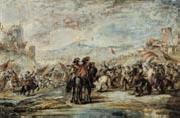 |
Francesco Simonini -- Click Here
|
|
Italian Painter, b. 1686, Parma, d. ca. 1753, Venezia, or Firenze |
|
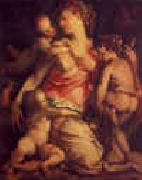 |
Francesco Salviati -- Click Here
|
|
Italian
1510-1563
Francesco Salviati Gallery |
|
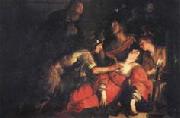 |
Francesco Rustici -- Click Here
|
|
Italian High Renaissance Sculptor, 1474-1554 |
|
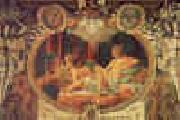 |
Francesco Primaticcio -- Click Here
|
|
Italian 1504-1570 Francesco Primaticcio Gallery
Born in Bologna, he trained under Giulio Romano in Mantua and became a pupil of Innocenzo da Imola, executing decorations at the Palazzo Te before securing a position in the court of Francis I of France in 1532.
Together with Rosso Fiorentino he was one of the leading artists to work at the Chateau Fontainebleau (where he is grouped with the so-called "First School of Fontainebleau") spending much of his life there. Following Rosso's death in 1540, Primaticcio took control of the artistic direction at Fontainebleau, furnishing the painters and stuccators of his team, such as Nicol?? dell'Abate, with designs. He made cartoons for tapestry-weavers and, like all 16th-century court artists, was called upon to design elaborate ephemeral decorations for masques and f??tes, which survive only in preparatory drawings and, sometimes, engravings. François trusted his eye and sent him back to Italy on buying trips in 1540 and again in 1545. In Rome, part of Primaticcio's commission was to take casts of the best Roman sculptures in the papal collections, some of which were cast in bronze to decorate the parterres at Fontainebleau.[1]
Primaticcio retained his position as court painter to François' heirs, Henri II and François II. His masterpiece, the Salle d'Hercule at Fontainebleau, occupied him and his team from the 1530s to 1559.
Primaticcio's crowded Mannerist compositions and his long-legged canon of beauty influenced French art for the rest of the century.
Primaticcio turned to architecture towards the end of his life, his greatest work being the Valois Chapel at the Abbey of Saint-Denis, although this was not completed until after his death and was destroyed in 1719. |
|
 |
Francesco Peluso -- Click Here
|
|
Italian, 19th century |
|
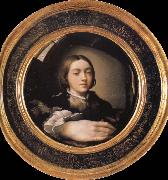 |
Francesco Parmigianino -- Click Here
|
|
1503 ~ 1540,Italian painter, draughtsman and printmaker. Beginning a career that was to last only two decades, he moved from precocious success in the shadow of Correggio in Parma to be hailed in the Rome of Clement VII as Raphael reborn. There he executed few large-scale works but was introduced to printmaking. After the Sack of Rome in 1527, he returned to northern Italy, where in his final decade he created some of his most markedly Mannerist works. Equally gifted as a painter of small panels and large-scale frescoes both sacred and profane, he was also one of the most penetrating portrait painters of his age. Throughout his career he was a compulsive draughtsman, not only of preparatory studies for paintings and prints, but also of scenes from everyday life and of erotica. |
|
 |
Francesco Morone -- Click Here
|
|
Italian Painter, 1471-ca.1529
was an Italian painter, active in Verona in a Renaissance style. He was the son of the Veronese painter Domenico Morone. The art biographer Vasari praised his frescoes (1505-7) for the cupola of the sacristy in Santa Maria in Organo. He also painted the organ shutters in that church. Paolo Cavazzola was one of his pupils. |
|
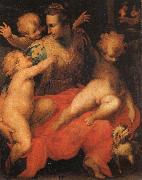 |
Francesco Morandini Da Poppi -- Click Here
|
|
Italian Painter (1544-1597) |
|
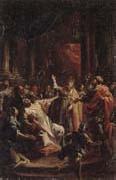 |
Francesco Monti -- Click Here
|
|
Italian Painter, 1685-1768
Italian painter and draughtsman. He was the son of a tailor who served the Este court in Modena during the 1690s. Monti studied with the foremost painter in Modena, Sigismondo Caula (b 1637), for three years from c. 1700. In 1703 he moved to Bologna and entered the studio of Giovanni Gioseffo dal Sole. Roli (1962) defined the formative influences on Monti's art as dal Sole and Donato Creti on the one hand, and Giuseppe Maria Crespi and Antonio Gionima on the other. Monti evolved a distinctive personal idiom, characterized by graceful figures reminiscent of the style of Parmigianino, but perhaps more directly inspired by the more extravagant late Mannerist idiom of such painters as Bartholomeus Spranger and Josef Heintz I of the court of Rudolf II at Prague. Monti may have known their work through prints by Aegidius Sadeler II, Jan Muller and others. This exotic figure style, with fluent, swaying forms and faces suggestively muted by half-shadow was accompanied by unusual shades of colour that glow richly in darkened settings. Monti's art contributed to a neo-Mannerist strain in 18th-century Emilian painting |
|
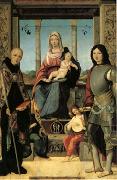 |
Francesco Marmitta -- Click Here
|
|
recorded at Parma 1496-1504 |
|
 |
Francesco Maria Schiaffino -- Click Here
|
|
Italian Rococo Era Sculptor, 1688-1763,Brother of Bernardo Schiaffino. He was the pupil and then assistant of Bernardo, who in 1721 sent him to complete his training in Rome, where he entered the workshop of Camillo Rusconi. He remained there until 1724, enriching his technique and cultural education by studying the works of Bernini, Rusconi and other sculptors. Back in Genoa, he executed such works as St Dominic (Genoa, Teatro Carlo Felice), in which Rusconi's influence is evident. The marble group of Pluto and Proserpine, sculpted for the Durazzo family and still in its original location (Genoa, Pal. Reale), is based on a bozzetto by Rusconi. In 1731 Schiaffino executed the grandiose Crucifix with Angels for King John V of Portugal (Mafra, Convent) and in 1738 began the theatrical funeral monument to Caterina Fieschi Adorno (Genoa, SS Annunziata di Portoria). The wax models of the Eight Apostles and Four Doctors of the Church that he modelled in 1739 (all untraced) were clearly inspired by the large Apostles by Rusconi and other sculptors in S Giovanni in Laterano, Rome. They were made for the stuccoist Diego Francesco Carlone so that he could, under Schiaffino's directions, execute 12 monumental statues in stucco (Genoa, S Maria Assunta in Carignano). In these latter works the classicizing authority of Rusconi's figures was transformed into a freer and more restless arrangement, the compact forms dissolving in the light, animated draperies. The statues reveal how Schiaffino had combined his knowledge of Roman sculpture with his study of Pierre Puget's Genoese works and with the style of the Piola workshop. He emulated the free rhythms of the Rococo found in the painting of Gregorio de' Ferrari, developing a decorative approach that is even more marked in the Assumption of the Virgin (1740; Varazze, S Ambrogio) and in the Rococo chapel of S Francesco da Paola (1755; Genoa, S Francesco da Paola), which he covered in polychrome marbles. His last works include the Virgin of Loreto (1762; Sestri Levante, Parish Church).
|
|
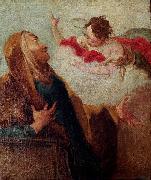 |
Francesco Maria Raineri -- Click Here
|
|
(February 2, 1676 - February 28, 1758) was an Italian painter of the late-Baroque, mainly active in Mantua.
Also called Lo Schivenoglia after the town, just outside of the city of Mantua, of his birth. He was a pupil of Giovanni Canti. Among his works, he was known for his paintings of battle scenes, landscapes, and cappriccios (vedute of imaginary scenes) with historical or mythologic figures. He was named director of the Academy of painters in Mantua in 1752. He is known to have painted a St. Sebastian for the chapel of Santa Anna. |
|
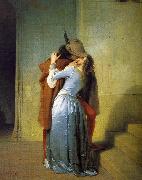 |
Francesco Hayez -- Click Here
|
|
1791-1882
Italian
Francesco Hayez Galleries
Hayez came from a relatively poor family from Venice. His father was of French origin while his mother, Chiara Torcella, was from Murano. The child Francesco, youngest of five sons, was brought up by his mother sister, who had married Giovanni Binasco, a well-off shipowner and collector of art. From childhood he showed a predisposition for drawing, so his uncle apprenticed him to an art restorer. Later he became a student of the painter Francisco Magiotto with whom he continued his studies for three years. He was admitted to the painting course of the New Academy of Fine Arts in 1806, where he studied under Teodoro Matteini. In 1809 he won a competition from the Academy of Venice for one year of study at the Accademia di San Luca in Rome. He remained in Rome until 1814, then moved to Naples where he was commissioned by Joachim Murat to paint a major work depicting Ulysses at the court of Alcinous. In the mid 1830s he attended the Salotto Maffei salon in Milan, hosted by Clara Maffei (whose portrait Hayez painted for her husband), and he was still in Milan in 1850 when he was appointed director of the Academy of Brera there.
Assessment of the career of Hayez is complicated by the fact that he often did not sign or date his works. Often the date indicated from the evidence is that at which the work was acquired or sold, not of its creation. Moreover he often painted the same compositions several times with minimal variations, or even with no variation. His early works show the influence of Ingres and the Nazarene movement. His later work participates in the Classical revival. |
|
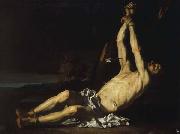 |
Francesco Guarino -- Click Here
|
|
(1611-1651 or 1654) was an Italian painter of the Baroque period, active mainly in the mountainous area east of Naples called Irpinia, and in other areas of Campania, Puglia, and Molise.
Francesco Guarino, Saint Agnes, 1650.He was born in Sant'Andrea Apostolo, today a frazione of Solofra in the Province of Avellino, Campania, and died in Gravina di Puglia. He was a pupil first locally of his father, Giovanni Tommaso Guarino, then moved to Naples to work in the studio of Massimo Stanzione. In Naples, like many of his contemporaries in Naples, he was influenced by the style of Caravaggio. Among his masterpieces are the works for the Collegiata di San Michele Arcangelo to Solofra.
|
|
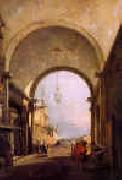 |
Francesco Guardi -- Click Here
|
|
1712-1793
Italian
Francesco Guardi Galleries
Francesco Guardi was born in Venice into a family of lesser nobility from Trentino. His father Domenico (born in 1678) and his brothers Niccolo and Gian Antonio were also painters, the latter inheriting the family workshop after the father's death in 1716. They probably all contributed as a team to some of the larger commissions later attributed to Francesco. His sister Maria Cecilia married the pre-eminent Veneto-European painter of his epoch, Giovanni Battista Tiepolo.
In 1735, Guardi moved to the workshop of Michele Marieschi, where he remained until 1743. His first certain works is from 1738, for a parish at Vigo d'Anuania, in Trentino. In this period he worked alongside his better-known brother, Gian Antonio. The first work signed by Francesco is a Saint Adoring the Eucarist (circa 1739).
His works in this period included landscapes as well as figure representations. His early vedutas show influence both from Canaletto and Luca Carlevarijs. On February 15, 1757 he married Maria Mattea Pagani, the daughter of painter Matteo Pagani. In the same year his brother Gian Antonio died and his first son, Vincenzo, was born. His second son, Giacomo, was born in 1764.
In 1763 he worked in Murano, in the church of San Pietro Martire, finishing a Miracle of a Dominican Saint clearly influenced by Alessandro Magnasco in its quasi-expressionistic style.
Francesco Guardi's most important later works include the Doge's Feasts, a series of twelve canvases celebrating the ceremonies held in 1763 for the election of Doge Alvise IV Mocenigo. In his later years, Canaletto's influence on his art diminished, as showed by the Piazzetta in the Ca' d'Oro of Venice. In circa 1778, he painted the severe Holy Trinity Appearing to Sts. Peter and Paul in the parish church of Roncegno.
Miracle of a Dominicane Saint (1763), Lugano, private collection.In 1782 Guardi was commissioned by the Venetian government six canvases to celebrate the visit of the Russian Archdukes in the city, of which only two remain, and two others for that of Pope Pius VI. On September 12 of that year he was admitted to the Fine Art Academy of Venice.
A stronger attention to colours is present in late works such as the Concerto of 80 Orphans of 1782, now in Munich, in the Façade of Palace with Staircase in the Accademia Carrara of Bergamo.
Guardi died at Venice in 1793. |
|
 |
Francesco Granacci -- Click Here
|
|
1477-1543
Italian
Francesco Granacci Galleries
Born at Villamagna di Volterra, he trained in Florence at the studio of Domenico Ghirlandaio, and was employed painting frescoes for San Marco on commission of Lorenzo de'Medici. He is featured in Giorgio Vasari's Vite.
His early works were influenced from the style of Filippino Lippi, like the Enthroned Madonna between Saint Michael and John the Baptist (Staatliche Museen, Berlin), Adoration of the Child (Honolulu Academy of Arts) and four histories of Saint John the Baptist.
In 1508, Granacci went to Rome, where, with other artists, he helped Michelangelo transfer cartoons to the Sistine chapel ceiling. The two artists were lifelong friends. Returning to Florence, Granacci painted a Madonna with Child with Saints Francesco and Jerome for the Augustinian convent of San Gallo (now in the Gallery of the Academy), a Madonna della Cintola for the Company of San Benedetto Bigi, and in 1515 he participated in creating the decorations to celebrate the visit to Florence of Pope Leo X. |
|
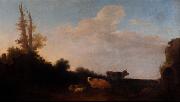 |
Francesco Giuseppe Casanova -- Click Here
|
|
(1727-1803) was an Italian painter and a younger brother of Giacomo Casanova.
Francesco Casanova Battaglia di cavalleria (oil on canvas, Louvre, Paris)Born in London, he trained in Venice under Francesco Guardi, then was a pupil of Francesco Simonini, a battle painter who took Borgognone as his model. Besides battle-pieces Casanova painted landscapes with figures and cattle, as well as pastoral subjects. He arrived in Paris in 1751, and went to Dresden in the following year, where he remained until 1757, spending his time in copying the finest battle-pieces of the famous Electoral Gallery. On his return to Paris he studied for a time under Charles Parrocel, and was received into the Academy in 1763. He exhibited at the Salon at intervals from that year till 1783, when he again quit France, going to Vienna, where he resided during the remainder of his life. Philip James de Loutherbourg was his pupil for a time.
|
|
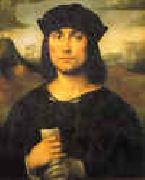 |
Francesco Francia -- Click Here
|
|
1450-1517
Italian
Francesco Francia Locations
He trained with Marco Zoppo and was first mentioned as a painter in 1486. His earliest known work is the Felicini Madonna, which is signed and dated 1494. He worked in partnership with Lorenzo Costa, and was influenced by Ercole de Roberti and Costa style, until 1506, when Francia became a court painter in Mantua, after which time he was influenced more by Perugino and Raphael. He himself trained Marcantonio Raimondi and several other artists; he produced niellos, in which Raimondi first learnt to engrave, soon excelling his master, according to Vasari. Raphael Santa Cecilia is supposed to have produced such a feeling of inferiority in Francia that it caused him to die of depression
His sons Jacopo Francia and Giulio Francia were also artists. |
|
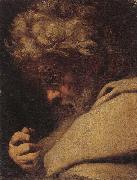 |
Francesco Fracanzano -- Click Here
|
|
Italian ,
b. Monopoli 1612-d.1656 Naples
Naples.Brother of Cesare Francanzano. He moved to Naples in 1622 with Cesare and like him entered Ribera's workshop. In 1632 he married Salvator Rosa's sister Giovanna. His early style remains obscure. Bologna (1958) attributed a group of paintings to him that show half-length figures against a predominantly dark background, painted in deep colours with loaded brushstrokes. These pictures, among them two versions of the Prodigal Son. |
|
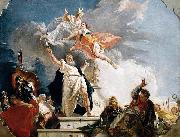 |
Francesco Fontebasso -- Click Here
|
|
(4 October 1707 - 31 May 1769) was an Italian painter painter of the late-Baroque or Rococo period of Venice. He first apprenticed with Sebastiano Ricci, but was strongly influenced by his contemporary, Giovanni Battista Tiepolo. In 1761, Fontebasso visited Saint Petersburg and produced ceiling paintings and decorations for the Winter Palace. Fontebasso returned to Venice in 1768. He helped decorate a chapel in San Francesco della Vigna.
He died in Venice in 1769.
|
|
 |
Francesco di Giorgio Martini -- Click Here
|
|
Italian Early Renaissance Painter and Sculptor, 1439-ca.1501
was an Italian painter of the Sienese School, a sculptor, an architect and theorist, and a military engineer who built almost seventy fortifications for the Duke of Urbino. Born in Siena, he apprenticed as a painter with Vecchietta. In panels painted for cassoni he departed from the traditional representations of joyful wedding processions in frieze-like formulas to express visions of ideal, symmetrical, vast and all but empty urban spaces rendered in perspective. Francesco di Giorgio is also known for architectural designs and sculptural work for Federico III da Montefeltro, Duke of Urbino, for whom he built star-shaped fortifications. He composed an architectural treatise Trattato di architettura, ingegneria e arte militare that he worked on for decades and finished sometime after 1482; |
|
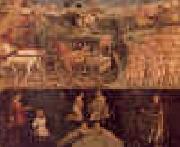 |
Francesco del Cossa -- Click Here
|
|
Italian
c1435-c1478
Francesco del Cossa Location
Italian painter. He was a leading representative of the Ferrarese school and was regarded, with Ercole de Roberti, as the founder of the Bolognese school. His principal works include The Glorification of March, April, and May, frescoes in the Schifanoia Palace, Ferrara; some admirable portraits of the artist contemporaries; Madonna Enthroned (Bologna); Madonna and Child with Angels, St. Liberal, and St. Lucy (National Gall. of Art, Washington, D.C.); and an altarpiece representing scenes from the life of St. Vincent Ferrer (National Gall., London, and the Vatican). |
|
|
|
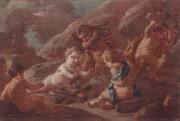 |
Francesco de mura -- Click Here
|
|
Italian Painter , b. 1696, Napoli, d. 1782, Napoli
was an Italian painter of the late-Baroque period, active mainly in Naples and Turin. His late work reflects the style of neoclassicism. He was a pupil of Francesco Solimena, then later with Domenico Viola, where he met his contemporary, Mattia Preti. While still in his teens he painted frescoes (1715) in San Nicola alla Carit?? in Naples. He painted ten canvases of the Virtues and an Adoration of the Magi (1728) for the church of Santa Maria Donnaromita. His other works include frescoes of the Adoration of the Magi (1732) in the apsidal dome of the church of the Nunziatella. |
|
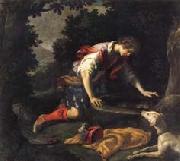 |
Francesco Curradi -- Click Here
|
|
Italian Baroque Era Painter, 1570-1661
son of Taddeo Curradi. He produced many devotional works and had a large clientele. At their best, the works are distinguished by lucid draughtsmanship, simple compositions and elegant, melancholy figures. Curradi was trained in the studio of Giovan Battista Naldini and in 1590 matriculated from the Accademia del Disegno, Florence. His first independent works include a Virgin and Child with Saints (1597; Volterra, S Lino) and a Birth of the Virgin (1598; Volterra Cathedral), both signed and dated. These paintings reflect the new clarity and directness introduced into Florentine painting by such artists as Santi di Tito and Jacopo Ligozzi. Subsequent works include a Crucifixion (1600) and a Virgin and Saints (1602; both Legnaia, S Angelo). In these the influence of Naldini yielded to that of Lodovico Cigoli and his circle, while the mildness of expression in the figures was inspired by Domenico Passignano. An album of 87 red chalk drawings, with scenes from the Life of St Mary Magdalene dei Pazzi (1606; Florence, convent of the Carmelites at Careggi) distinguished by their precision and clear, characteristically Florentine compositions, contributed to the iconography of this popular Counter-Reformation saint. In 1607 Curradi was commissioned to portray her mortal remains, and this painting, together with the drawings, |
|
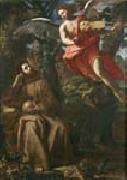 |
Francesco Cozza -- Click Here
|
|
1605-1682)was an Italian painter of the Baroque period.
He was born in Stilo in Calabria and died in Rome. As a young man, he went to Rome and apprenticed with Domenichino. He traveled with Domenichino to Naples.
He is best known for his expansive panegyric ceiling fresco, Apotheosis of Pamphili House, in the library of Palazzo Pamphili in Piazza Navona (1667-73). He also frescoed the Stanza del Fuoco in Palazzo Pamphili in Valmontone, 1658-59), where he worked along with Pier Francesco Mola, Gaspar Dughet, Mattia Preti, Giovanni Battista Tassi (il Cortonese), and Guglielmo Cortese. He also participated with Carlo Maratta and Domenico Maria Canuti in fresco decorations of the Palazzo Altieri. His landscape paintings recall the Carracci style of paesi con figure piccole (landscapes with small figures). He painted a Madonna del Riscatto in church of Santa Francesca Romana. He was received into the Accademia di San Luca at Rome in 1650. |
|
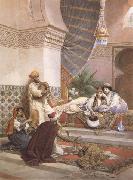 |
Francesco Coleman -- Click Here
|
|
Italian, 1851-1918 |
|
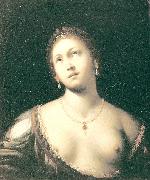 |
Francesco Cairo -- Click Here
|
|
(1607-1665) was an Italian painter active in Baroque Lombardy and Piedmont.
He was born and died in Milan. It is not known where he obtained his early training though he is strongly influenced by the circle of il Morazzone, in works such as the Saint Teresa altarpiece in the Certosa di Pavia.
In 1633, Cairo moved to Turin to work as a court painter, including portraits, to Vittorio Amedeo I of the House of Savoy. Between 1637-1638, Cairo travelled to Rome, where he encounters the works of Pietro da Cortona, Guido Reni and of the Caravaggisti. He returns to Lombardy to complete altarpieces for the Certosa of Pavia and a church at Casalpusterlengo. He painted a St. Theresa for San Carlo in Venice. Between 1646-1649, he returns to Turin, and paints an altarpiece for Savigliano and the church of San Salvario. He is also known as Il Cavaliere del Cairo, because in Turin, he received the order of SS. Lazarus and Maurice in recognition of his merit.
Many of his works are eccentric depictions of religious ecstasies; the saints appear liquefied and contorted by piety. He often caps them with exuberant, oriental turbans. |
|
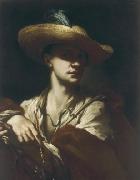 |
Francesco Caccianiga -- Click Here
|
|
Francesco Caccianiga (1700-1781) was an Italian painter and engraver.
He was born in Milan. In Bologna, he became a pupil of Marcantonio Franceschini. He afterwards visited Rome, where he established himself under the patronage of Prince Borghese, for whom he executed some considerable works in the Palazzo and the Villa Borghese. His principal works are at Ancona, where he painted several altar-pieces, among them, Marriage of the Virgin and Last Supper. |
|
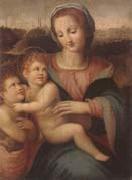 |
Francesco Brina -- Click Here
|
|
Italian ,
Florence cIRCA 1540-1585/6
|
|
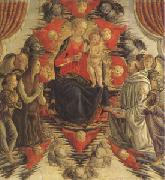 |
Francesco Botticini -- Click Here
|
|
Florence 1446-1497 |
|
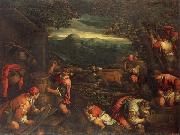 |
Francesco Bassano the younger -- Click Here
|
|
Bassano 1549-Venice 1592
|
|
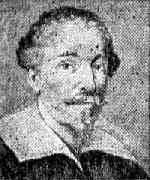 |
Francesco Albani -- Click Here
|
|
(March 17 or August 17, 1578 COctober 4, 1660) was an Italian Baroque painter.
Born at Bologna, his father was a silk merchant who intended to instruct his son in the same trade; but by age twelve, Albani became an apprentice under the competent mannerist painter Denis Calvaert, where he met Guido Reni. Soon he followed Reni to the so-called "Academy" run by the Carracci family: Annibale, Agostino, and Ludovico. This studio fostered the careers of many painters of the Bolognese school, including Domenichino, Massari, Viola, Lanfranco, Giovanni Francesco Grimaldi, Pietro Faccini, Remigio Cantagallina, and Reni.
In the year 1600, Albani moved to Rome to work in the fresco decoration of the gallery of the Palazzo Farnese, being completed by the studio of Annibale Carracci. Rome, under Clement VIII Aldobrandini (1592-1605) was exhibiting some degree of administrative stability and renewed artistic patronage. While pope Clement was born from a Florentine family residing in Urbino, his family was allied by marriage to the Emilia-Romagna and the Farnese, since Ranuccio I Farnese, Duke of Parma had married Margherita Aldobrandini. Parma, like Bologna, are part of the Region of Emilia-Romagna. Thus it was not surprise that Cardinal Odoarde Farnese, Ranuccio's brother, chose the Carraccis from Bologna for patronage, thereby establishing Bolognese predominance of Roman fresco painting for nearly two decades. |
|
|
|
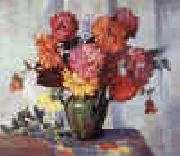 |
Frances Hudson Storrs -- Click Here
|
|
1860-1945
Frances Hudson Storrs Gallery |
|
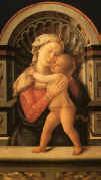 |
Fra Filippo Lippi -- Click Here
|
|
Italian
1406-1469
Fra Filippo Lippi Galleries
Lippi was born in Florence to Tommaso, a butcher. Both his parents died when he was still a child. Mona Lapaccia, his aunt, took charge of the boy. In 1420 he was registered in the community of the Carmelite friars of the Carmine in Florence, where remained until 1432, taking the Carmelite vows in 1421 when he was sixteen. In his Lives of the Artists, Vasari says: "Instead of studying, he spent all his time scrawling pictures on his own books and those of others," The prior decided to give him the opportunity to learn painting. Eventually Fra Filippo quit the monastery, but it appears he was not released from his vows; in a letter dated 1439 he describes himself as the poorest friar of Florence, charged with the maintenance of six marriageable nieces. In 1452 he was appointed chaplain to the convent of S. Giovannino in Florence, and in 1457 rector (Rettore Commendatario) of S. Quirico in Legania, and made occasional, considerable profits; but his poverty seems chronic, his money being spent, according to one account, in frequent amours. Vasari relates some romantic adventures of Fra Filippo that modern biographers are not inclined to believe. Except through Vasari, nothing is known of his visits to Ancona and Naples, nor of his capture by Barbary pirates and enslavement in Barbary, where his skill in portrait-sketching helped to release him. From 1431 to 1437 his career is not accounted for.
Portrait of a Man and Woman at a Casement , c. 1440
Metropolitan Museum of Art, New York City.In June 1456 Fra Filippo is recorded as living in Prato (near Florence) to paint frescoes in the choir of the cathedral. In 1458, while engaged in this work, he set about painting a picture for the convent chapel of S. Margherita of Prato, where he met Lucrezia Buti, the beautiful daughter of a Florentine, Francesco Buti; she was either a novice or a young lady placed under the nuns' guardianship. Lippi asked that she might be permitted to sit for the figure of the Madonna (or perhaps S. Margherita). Under that pretext, Lippi engaged in sexual relations with her, abducted her to his own house, and kept her there despite the nuns' efforts to reclaim her.
The result was their son Filippino Lippi, who became a painter no less famous than his father. Such is Vasari's narrative, published less than a century after the alleged events; it is not refuted by saying, more than three centuries later, that perhaps Lippo had nothing to do with any such Lucrezia, and perhaps Lippino was his adopted son, or only an ordinary relative and scholar. The argument that two reputed portraits of Lucrezia in paintings by Lippo are not alike, one as a Madonna in a very fine picture in the Pitti gallery, and the other in the same character in a Nativity in the Louvre, comes to very little; and it is reduced to nothing when the disputant adds that the Louvre painting is probably not done by Lippi at all[clarification needed]. Besides, it appears more likely that not the Madonna in the Louvre but a S. Margaret in a picture now in the Gallery of Prato is the original portrait (according to tradition) of Lucrezia Buti.
The frescoes in the choir of Prato cathedral, which depict the stories of St John the Baptist and St Stephen on the two main facing walls, are considered Fra Filippo's most important and monumental works, particularly the figure of Salome dancing, which has clear affinities with later works by Sandro Botticelli, his pupil, and Filippino Lippi, his son, as well as the scene showing the ceremonial mourning over Stephen's corpse. This latter is believed to contain a portrait of the painter, but there are various opinions as to which is the exact figure. On the end wall of the choir are S. Giovanni Gualberto and S. Alberto, while the vault has monumental representations of the four evangelists.
The close of Lippi's life was spent at Spoleto, where he had been commissioned to paint, for the apse of the cathedral, scenes from the life of the Virgin. In the semidome of the apse is Christ crowning the Madonna, with angels, sibyls and prophets. This series, which is not wholly equal to the one at Prato, was completed by Fra Diamante after Lippi's death. That Lippi died in Spoleto, on or about the 8th of October 1469, is a fact; the mode of his death is a matter of dispute. It has been said that the pope granted Lippi a dispensation for marrying Lucrezia, but before the permission arrived, Lippi had been poisoned by the indignant relatives of either Lucrezia herself or some lady who had replaced her in the inconstant painter's affections. This is now generally regarded as a fable, and indeed, a vendetta upon a man aged sixty-three for a seduction committed at the age of fifty-two seems hardly plausible. Fra Filippo lies buried in Spoleto, with a monument erected to him by Lorenzo the Magnificent; he had always been zealously patronized by the Medici family, beginning with Cosimo de Medici. Francesco di Pesello (called Pesellino) and Sandro Botticelli were among his most distinguished pupils.
The altarpiece Lippi painted in 1441 for the nuns of S. Ambrogio is now a prominent attraction in the Academy of Florence, and was celebrated in Browning's well-known poem. It represents the coronation of the Virgin among angels and saints, including many Bernardine monks. One of these, placed to the right, is a half-length portrait of Lippo, pointed out by the inscription perfecit opus upon an angel's scroll. The price paid for this work in 1447 was 1200 Florentine lire, which seems surprisingly large.
Selfportait with pupilsFor Germiniano Inghirami of Prato he painted the Death of St. Bernard. His principal altarpiece in this city is a Nativity in the refectory of S. Domenico ?? the Infant on the ground adored by the Virgin and Joseph, between Saints George and Dominic, in a rocky landscape, with the shepherds playing and six angels in the sky. In the Uffizi is a fine Virgin adoring the infant Christ, who is held by two angels; in the National Gallery, London, a Vision of St Bernard. The picture of the Virgin and Infant with an Angel, in this same gallery, also ascribed to Lippi, is disputable.
Filippo Lippi died in 1469 while working on the frescos Storie della Vergine (Scenes of the life of the Virgin Mary, 1467 - 1469) in the apse of the Spoleto Cathedral. The Frescos show the Annunciation, the Funeral, the Adoration of the Child and the Coronation of the Virgin. A group of bystanders at the Funeral includes a self-portrait of Lippi together with his son Fillipino and his helpers Fra Diamante and Pier Matteo d'Amelia. Lippi was buried on the right side of the transept.
The frescos were completed by Filippino Lippi, who also designed the funerary monument for his father. Although it was commissioned by Lorenzo de Medici it was not actually made until 1490 by an unknown Florentine sculptor. |
|
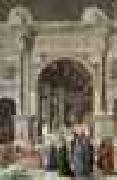 |
Fra Carnevale -- Click Here
|
|
Italian, active 1445-1484 |
|
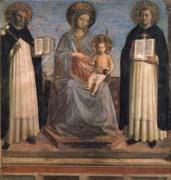 |
Fra Beato -- Click Here
|
|
Florentine painter , ca.1400-1455
|
|
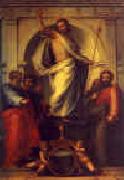 |
Fra Bartolommeo -- Click Here
|
|
Italian c1474-c1517
Fra Bartolommeo Location
Italian painter and draughtsman. Vasari and later historians agree that Fra Bartolommeo was an essential force in the formation and growth of the High Renaissance. He was the first painter in Florence to understand Leonardo da Vincis painterly and compositional procedures. Later he created a synthesis between Leonardos tonal painting and Venetian luminosity of colour. Equally important were his inventions for depicting divinity as a supernatural force, and his type of sacra conversazione in which the saints are made to witness and react to a biblical event occurring before their eyes, rather than standing in devout contemplation, as was conventional before. His drawings, too, are exceptional both for their abundance and for their level of inventiveness. Many artists came under his influence: Albertinelli, Raphael, Andrea del Sarto, Titian, Correggio, Beccafumi, Pontormo and Rosso Fiorentino. |
|
|